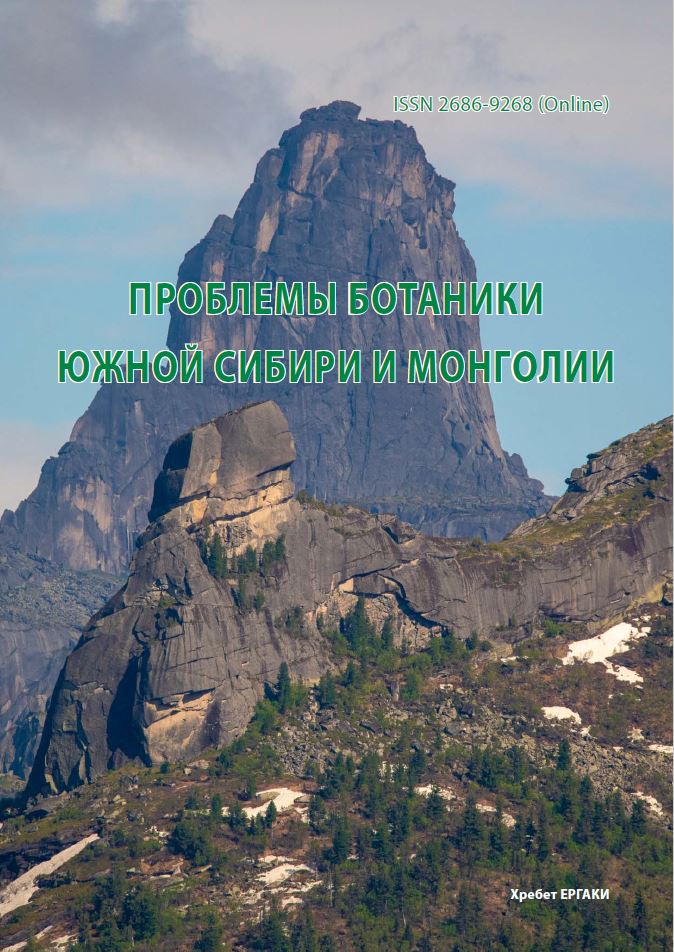The experience of the primary introduction of Fritillaria karelinii in the Main botanical garden of Almaty
УДК 582.572.2:581.6*615(574-25)
Abstract
Botanical gardens play an important role in the study and conservation of plant genetic resources where the biological features and adaptive capabilities of the biomorphological diversity of the involved plant species are studied for the subsequent prediction of the success of their introduction. The object of research was the early flowering bulbous ephemeroid of the desert territories of southern Russia, Central and Central Asia Fritillaria karelinii (Fisch. ex D. Don) Baker (syn. Rhinopetalum karelinii Fisch. ex D. Don). Due to hard harvesting of the species in the territory of Kazakhstan, exported to China where Fritillaria karelinii bulbs are used in Chinese medicine, there was a real need to study the features and methods of growing this species in culture. In carrying out the research, generally accepted methods of introducing herbaceous plants were used. An analysis of literary sources showed the availability of limited information on the cultivation of the species in Russia and neighboring countries. We studied the introduction populations of Fritillaria karelinii attracted in different years from places of natural growth in the south-east of Kazakhstan. When introduced in the Main Botanical Garden of the Institute of Botany and Phytointroduction (Almaty), the regrowth of the species begins in early March, 1-3 days after the snow cover melts. Flowering of the species in different years and in different populations begins in the first half of April, approximately 20 days after regrowth. The capsule is formed immediately after the flowering of the flower, the seeds ripen 40-50 days after flowering. The duration of the growing season of the species is 60-70 days. Attempts at seed propagation of Fritillaria karelinii undertaken by seeds from natural populations in autumn and spring did not give positive results. There is a clear trend towards a decrease in the total number and generative function of the introductory population as early as 2-3 years after its formation. The survival rate of the material depends both on the quality of the planted bulbs and the timing of their digging in natural populations.
Downloads
Metrics
References
Лозина-Лозинская A. C. Род Rhinopetalum Fisch. // Флора СССР под ред. В. Л. Комарова. - Л.: Изд. АН СССР, 1935. - T. IV. - С. 296-297.
Турсынбай А., Гемеджиева Н. Г., Сапаров К. А. Выявление особенностей распространения Fritillaria karelinii (Fisch. ех D. Don) Baker на юго-востоке Казахстана // Вестник Карагандинского университета. Серия «Биология. Медицина. География», 2020. - № 4 (100). - C. 85-93. DOI: 10.31489/2020BMG4/85-93
Иващенко А. А. Тюльпаны и другие луковичные растения Казахстана. - Алматы: ИД «Две Столицы», 2005. - С. 136-137.
Бочанцева 3. П. К морфологии и биологии представителей родов петилиум, корольковия и ринопеталум // Интродукция и акклиматизация растений. - Ташкент, 1962. - Вып. 2. - С. 5-35.
Ищенко Л. Е., Атаева М. Б., Соболева Л. Е., Абрамова С. Н. Декоративные травянистые растения Туркмении. - Ашхабад: «ЫЛЫМ», 1972. - С. 30-33.
Ротов Р. А. Некоторые итоги интродукции видов рода Fritillaria s. l. // Бюлл. Гл. бот. сада АН СССР. - М., 1972. - Вып. 86. - С. 12-15.
Растения природной флоры Казахстана в интродукции. Справочник. - Алма-Ата: «Гылым», 1990. - С. 117-118.
RixM., ZarreiM. 580. Fritillaria karelinii // Curtis’s Botanical Magazine, 2007. - Vol. 24. - P. 46-49. DOI: 10.1111/j.1467-8748.2007.00559.x
Rousted N., Law S., Thornton H., Fay M. F., Chase M. W. Molecular phylogenetic evidence for the monophyly of Fritillaria and Lilium (Liliaceae; Liliales) and the infrageneric classification of Fritillaria // Molecular Phylogenetics and Evolution, 2005. - Vol. 35. - P. 509-527.
Sad mnogoletnikov. URL: https://flosad.ucoz.ru/publ/alfavitnyj_ukazatel/p/rjabchik_fritillaria_fritilljarija/19-1-0-153. (Accessed 17 March 2023).
Zvetochniy dom. URL: https://www.flowers-house.ru/content.php?r=1635-Ryabchik. (Accessed 17 March 2023).



